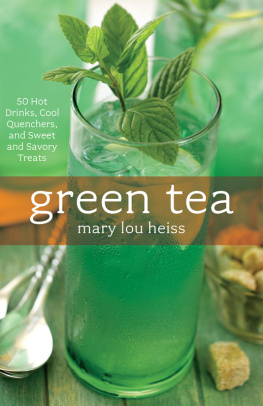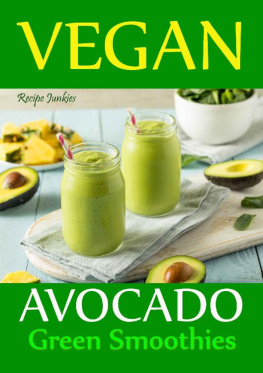Heiss - Green tea: 50 hot drinks, cool quenchers, and sweet and savory treats
Here you can read online Heiss - Green tea: 50 hot drinks, cool quenchers, and sweet and savory treats full text of the book (entire story) in english for free. Download pdf and epub, get meaning, cover and reviews about this ebook. City: Boston;Mass, year: 2006, publisher: Harvard Common Press, genre: Home and family. Description of the work, (preface) as well as reviews are available. Best literature library LitArk.com created for fans of good reading and offers a wide selection of genres:
Romance novel
Science fiction
Adventure
Detective
Science
History
Home and family
Prose
Art
Politics
Computer
Non-fiction
Religion
Business
Children
Humor
Choose a favorite category and find really read worthwhile books. Enjoy immersion in the world of imagination, feel the emotions of the characters or learn something new for yourself, make an fascinating discovery.
- Book:Green tea: 50 hot drinks, cool quenchers, and sweet and savory treats
- Author:
- Publisher:Harvard Common Press
- Genre:
- Year:2006
- City:Boston;Mass
- Rating:5 / 5
- Favourites:Add to favourites
- Your mark:
- 100
- 1
- 2
- 3
- 4
- 5
Green tea: 50 hot drinks, cool quenchers, and sweet and savory treats: summary, description and annotation
We offer to read an annotation, description, summary or preface (depends on what the author of the book "Green tea: 50 hot drinks, cool quenchers, and sweet and savory treats" wrote himself). If you haven't found the necessary information about the book — write in the comments, we will try to find it.
Heiss: author's other books
Who wrote Green tea: 50 hot drinks, cool quenchers, and sweet and savory treats? Find out the surname, the name of the author of the book and a list of all author's works by series.
Green tea: 50 hot drinks, cool quenchers, and sweet and savory treats — read online for free the complete book (whole text) full work
Below is the text of the book, divided by pages. System saving the place of the last page read, allows you to conveniently read the book "Green tea: 50 hot drinks, cool quenchers, and sweet and savory treats" online for free, without having to search again every time where you left off. Put a bookmark, and you can go to the page where you finished reading at any time.
Font size:
Interval:
Bookmark:
For Bob,
who never flinched when asked
to taste a new recipe:
You are the best cheerleader
a girl could wish for.
The Harvard Common Press
535 Albany Street
Boston, Massachusetts 02118
www.harvardcommonpress.com
Copyright 2006 by Mary Lou Heiss
Photographs copyright 2006 by Eskite Photography
All rights reserved. No part of this publication may be reproduced or transmitted in any form or by any means, electronic or mechanical, including photocopying, recording, or any information storage or retrieval system, without permission in writing from the publisher.
The Library of Congress has cataloged the print edition as follows:
Heiss, Mary Lou.
Green tea : 50 hot drinks, cool quenchers, and sweet and savory treats / Mary Lou Heiss.
p. cm.
Includes index.
ISBN 1-55832-298-1 (hardcover : alk. paper)
1. Cookery (Tea) 2. Green tea. I. Title.
TX817.T3H45 2006
641.6'372dc22
2005023807
ISBN-13: 978-1-55832-298-1
ISBN-10: 1-55832-298-1
eISBN 978-1-55832-564-7
v1.0613
Special bulk-order discounts are available on this and other Harvard Common Press books. Companies and organizations may purchase books for premiums or resale, or may arrange a custom edition, by contacting the Marketing Director at the address above.
Photographer: Richard Eskite; photo assistant: Brad Ryder; producer: Juliann Harvey; food styling: Andrea Lucich; food styling assistant: Caitlyn Hicks; prop styling: Carol Hacker
Without the enthusiasm of The Harvard Common Press, this book would still be a dream. My sincere appreciation goes to Bruce Shaw, Valerie Cimino, Christine Corcoran Cox, and the rest of the talented team for all that they have done to make this book shine. Thanks also to Pam Hoenig for her early belief in this book, and to my agent, Lisa Ekus, for friendship and trust, the best part of the deal.
In China and Japan, green tea is the fuel that drives and invigorates the daily lives of millions. From early morning until late at night, cups of fresh, fragrant green tea poured from steaming teapots provide an uplifting and relaxing break from the hectic pace of daily life. Much like Westerners and their beloved cups of coffee, many Asians never let their lidded cups of tea stray too far from sight.
Today, as in the past, housewives, students, workers, and travelers rely on the social pleasures of the local teahouse to provide a calm and meditative place for relaxing or catching up with a friend on the latest news. Accompanied by simple snacks, a modest cup of green tea soothes away the rough edges of the day and connects the drinker with social and cultural traditions of tea drinking that have endured for centuries.
The culture of green tea drinking in China and Japan goes beyond mere refreshment, as it is meant to engage and delight the senses through careful attention to both the preparation and the drinking of the tea. Much has been written by Chinese monks and Japanese Zen scholars to underscore the necessity for ritual in tea preparation. Additionally, writers and poets enthusiastically note the pleasures one can expect from drinking a cup of this tranquil, liquid jade.
Even with todays busy schedules, the classical nature of tea drinking in China and Japan is still respected. Tea drinking in Asia involves more than just the drinking of tea. The cups, water, room decorations, and soundsor absence of soundsare all important, and were deemed so in the Tang Dynasty. It is these elements that give tea its classical nature. For the tea drinker, the sound of hot tea being poured from teapot to cup is reminiscent of pure, clean water gently coursing in a rocky stream. The translucent golden-green color of the tea in the hollow of a teacup should be visually pleasing, and the shape and design of the teacup should be engaging and feel good in the hand. The fragrance of the tea should stimulate the palate in anticipation of the flavor of the brew, which, upon tasting, should be delicate and fresh, reminding one of the cool, misty mountain of its origin.
Light in flavor, lower in caffeine than black tea or coffee, clean and contemporary in style, green tea is the beverage of choice for more than half the worlds population. Twenty-somethings worldwide seem to find that the essence of green tea is more to their liking than black tea, and they are spreading the idea that green tea is not your grandmothers cup of tea. Consumption of this pleasing beverage is spiraling upward in the West. Americans are challenging the popularity of traditional black tea by embracing the numerous styles of green tea available in specialty tea shops and from online tea merchants. Additionally, bottled green tea beverages are gaining a larger presence on grocers shelves, and cafs and restaurants continue to add more choices of green tea. Green tea is the perfect, easy-to-brew, and delicious beverage of choice for a new generation of tea drinkers. Its healthful as well: medical research is finding that drinking three to four cups of green tea a day may help to reduce blood pressure, bolster immunity, protect skin from free-radical damage, and lower the incidence of cancer.
Hot or iced, plain or with spice or citrus, green tea is one of lifes simple and satisfying pleasures. Adopt an Asian attitude and enjoy the many delights of this timeless beverage.

Second only to water in consumption, green tea is a modern-day cultural icon in China, Japan, and South Korea. This staple of Asian life has spent 2,000 years earning its title as the worlds oldest beverage.
A delicious cup of hot or iced green tea always starts with high-quality tea. Yielding 50 cups of tea per 4 ounces of dry leaves, exquisite green teas are an amazingly affordable luxury. Buy your tea from respected retailers or companies that you trust and that specialize in fine teas. Avoid inexpensive tea no matter how good a bargain it seems to beits not really a bargain, as it is guaranteed to make a disappointing brew.
Leaf styles differ significantly between Chinese and Japanese green tea. Each is unique and reflects the practices and distinctive traditions of tea culture in these countries. While all tea bushes are of the same species of flowering evergreen, Camellia sinensis, it is the size of the leaf when it is plucked and the method of leaf manufacture that is responsible for the distinctions among green teas. Japanese green teas number fewer than a dozen choices, while it is thought that more than 8,000 distinctions of green tea are produced in the vast tea-producing regions of China.
In China, green tea is brewed from whole dried leaves. Elegant, clean, and fresh in flavor, the finest Chinese green teas are picked in the early spring and are prized for their artistically shaped, rolled or twisted hand-processed leaves. Chinese teas are rarely steamed, and can be machine shaped or traditionally hand processed in tea-firing pans or baskets, resulting in a dazzling assortment of shapes such as spirals and twists, pearls and balls, swords, tips and buds (sparrow tongues), and flat, pressed leaves.
Here at home, look in specialty tea shops or on the Internet (see Resource Guide, ) for fine-quality teas with lyrical names such as Bamboo Tips, Mengding Mt. Snow Buds, Jade in the Clouds, Emerald Forest, Bubbling Spring, Ming Mei, Qi Mt. Dragon Whiskers, and Purple Bamboo. These names and distinctive leaf styles reflect Chinas ancient tea culture, and remind us that something as simple as a handful of tea leaves can offer the opportunity for dreamy reflection.
Next pageFont size:
Interval:
Bookmark:
Similar books «Green tea: 50 hot drinks, cool quenchers, and sweet and savory treats»
Look at similar books to Green tea: 50 hot drinks, cool quenchers, and sweet and savory treats. We have selected literature similar in name and meaning in the hope of providing readers with more options to find new, interesting, not yet read works.
Discussion, reviews of the book Green tea: 50 hot drinks, cool quenchers, and sweet and savory treats and just readers' own opinions. Leave your comments, write what you think about the work, its meaning or the main characters. Specify what exactly you liked and what you didn't like, and why you think so.











